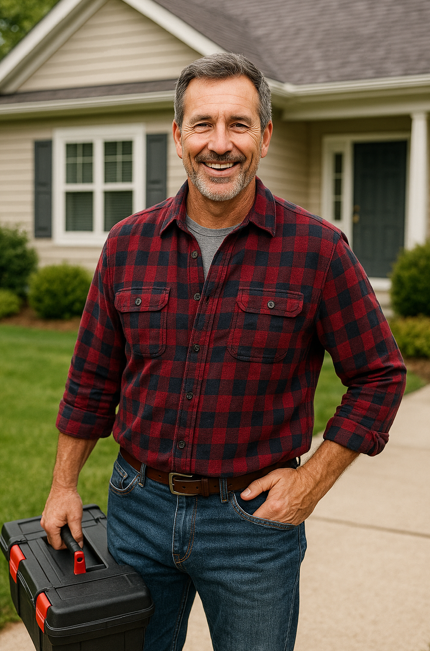🤝 Hey Folks, Mike Sanders Here: Let’s Troubleshoot That Furnace
Howdy friends, it’s Mike. I know the feeling—you turn up the thermostat on a cold morning and nothing happens. Or maybe your furnace is blowing air, but it’s not warm. Before you call in the cavalry (aka your HVAC tech), there are a few things you can check yourself.
Electric furnaces are generally reliable, but they do have moving parts and sensitive electrical systems that can wear out over time. In this guide, I’ll cover the most common problems I’ve seen in the field and how homeowners like you can troubleshoot them safely.
⚡️ Problem #1: Furnace Won’t Turn On
If your system is completely unresponsive, start here:
Possible Causes:
-
Tripped breaker in your panel
-
Blown internal fuse in the furnace cabinet
-
Faulty thermostat
-
Disconnected wiring or loose terminals
What to Do:
-
Check your main electrical panel for a tripped double-pole breaker. Reset if necessary.
-
Open the furnace cabinet and inspect for blown fuses (shut off power first).
-
Test your thermostat by replacing the batteries and checking the set temperature.
-
Look for visible signs of burned or loose wires.
If the unit still doesn’t respond, it could be a failed control board. That’s a job for a licensed pro.
More guidance available from Family Handyman’s furnace troubleshooting guide.
🔥 Problem #2: Furnace Blows Cold Air
Warm air isn’t just a luxury—it’s the job. If your furnace is running but pushing out cold air, here are some potential culprits.
Possible Causes:
-
Burnt out heating element
-
Open limit switch (safety sensor triggered)
-
Improper thermostat setting (fan set to ON)
-
Loose wiring on heat sequencer
What to Do:
-
Make sure the thermostat is set to "AUTO," not "ON"
-
Inspect heating elements with a multimeter (after cutting power)
-
Reset the limit switch if it’s manually resettable
-
Check for loose connections on the sequencer
Be cautious: Repeated tripping of the limit switch could mean restricted airflow or overheating due to dirty filters or a failing blower motor.
For electrical heating elements, refer to HVAC School’s electric heat lesson.
🌡️ Problem #3: Furnace Cycles On and Off Too Frequently (Short Cycling)
Short cycling is when your furnace starts up, runs briefly, and shuts off again—repeatedly.
Common Causes:
-
Oversized furnace for your home
-
Dirty air filter restricting airflow
-
Faulty thermostat placement near heat source
-
Blower motor overheating and shutting down
What to Do:
-
Replace or clean the air filter
-
Make sure thermostat isn’t near a sunny window or heat vent
-
Inspect blower motor vents and bearings for overheating
If the furnace is truly oversized, you might need a load calculation to verify. No fix here besides a full system change or adding zoning to distribute heat more effectively.
Explore filter replacement benefits in this ENERGY STAR HVAC maintenance checklist.
🚫 Problem #4: Blower Motor Doesn’t Run
The blower is what actually pushes warm air through your house. If it stops, your heat can’t get where it needs to go.
Possible Issues:
-
Failed capacitor (especially in PSC motors)
-
Worn-out blower motor
-
Faulty fan relay or control board
What to Do:
-
Listen for humming or buzzing from the blower compartment
-
Check the capacitor with a multimeter (watch for discharge!)
-
Inspect motor shaft for binding or burnt smell
-
Check blower wheel for debris or obstructions
If it’s an ECM (electronically commutated motor), the diagnostic gets a little more advanced. You’ll want a tech with the right gear.
More on motor diagnostics at Untied HVAC Motors’ blower motor testing guide.
🌌 Bonus Tips: Preventing Future Breakdowns
Electric furnaces last a long time—often 20 years or more—but only if they’re cared for properly.
Mike’s Quick Maintenance Checklist:
-
Change filters every 1-3 months
-
Vacuum return vents and registers
-
Keep panel area clear for airflow and service
-
Schedule annual electrical and duct inspection
Also make sure your system is compatible with smart thermostats and that firmware updates are done when needed.
👀 When to Call a Pro
If you’ve tried the above and still have no heat—or if anything smells like burning plastic or you hear electrical popping—shut the system off immediately and call a licensed HVAC contractor.
A qualified tech can:
-
Test internal components safely
-
Diagnose advanced control board issues
-
Perform load testing on circuits
-
Make safe replacements that stay up to code
Also worth noting: some issues may qualify for warranty coverage, especially if your system is less than 10 years old.
🏠 Final Thoughts: A Little Know-How Goes a Long Way
Electric furnaces are some of the most reliable heating systems out there, but like any mechanical system, they can run into hiccups. By learning a few basics and knowing when to bring in a pro, you can keep your home safe, warm, and worry-free.
If you’re looking to replace a failing unit or upgrade to something more efficient, check out The Furnace Outlet’s electric furnace collection for top-rated models and real customer support.
Stay warm and stay in control,
Mike Sanders







